Back in April we assisted John Black with the Buffalo Ornithological Society (BOS) spring count and he indicated that a repeat in May would be a real possibility. Well it was. But before Jean and I would start counting in the area we covered last time we had the privilege of birding the west pier of the Welland Canal in Port Weller.
After meeting John, Katherine and Dan at the usual spot we headed over to the Welland Canal for some early morning birding along the pier and in Malcomson Eco Park. Travelling down Airport Rd in Niagara-on-the-Lake we stopped at a golf course in search of the Great Horned Owl that was nesting in a tree on the northern edge of the course. The nest can be viewed from the road but we arrived as the owner was preparing to open the course and we were allowed access to gain a closer look at the nest. The nest was empty but Dan picked up on a most interesting song. It was only 7:15 AM and it would be the best bird of the day. Dan informed us the song was that of a Clay-colored Sparrow. I told him we needed to view this bird as it would be a lifer for Jean and I. For us to tick a life bird, Jean and I need to actually see it. We set off in the direction of the insectlike buzzes. There were a few conifers spread along the fairways and it seemed likely that the sparrow was in one of these trees. Sure enough, at the top of a spruce tree, there stood a Clay-colored Sparrow singing away. With the morning sun at our backs we had some great views of lifer #292. Though the sparrow is known to nest in the Hamilton Study Area (Bob Curry's Birds of Hamilton and Surrounding Areas) John informed me that this bird was only the 7th record in the Niagara Region! An epic observation indeed! For information on the other records you'll have to purchase John and Kayo's soon to be released book "Niagara Birds".
Jean had heard another bird's call while we were there. It was the call of a Ring-necked Pheasant. After viewing the Clay-colored Sparrow we scanned the neighbouring field and observed the pheasant in the distance. Jean and I went all year last year without observing this introduced Asian species so it was a very welcomed tick. The road to 200 is getting better. Urban development has reduced the number of pheasant in St. Catharines.
Onto the west pier and this time the gate would automatically open after punching in a code. No pushing the heavy gate as was needed on the MNR count on a cold January day.
Large numbers of Double-crested Cormorants were roosting in trees as we drove along the pier. We were following Dan's vehicle and I held back a bit as the disturbed cormorants left their roost. I did not want them evacuating that foul odoured waste onto the Subaru. Really. Must cormorants evacuate where they roost and nest?
Starting at the Canada Coast Guard station, we walked along the pier until we reached the lake. Migrants were everywhere! First of the years added included Chestnut-sided Warbler, Warbling Vireo, Palm Warbler, Northern Parula, House Wren and Gray Catbird.
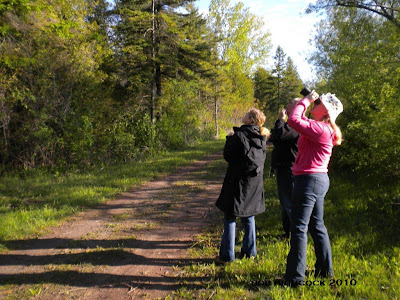
Viewing the gulls in May is far more enjoyable than it is in January.

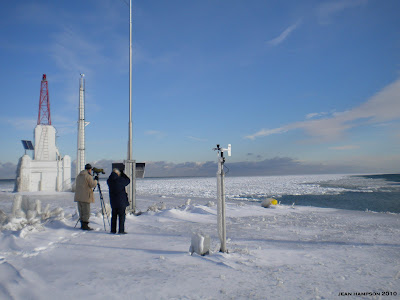
After an hour of birding on the west pier we went to neighbouring Malcomson Park. John, Jean and I birded one area of the eco park while Katherine and Dan searched the other. Jean and I added Swainson's Thrush, Veery, Eastern Wood-Pewee and Least Flycatcher to the 2010 list. First of the year warblers included, Black-throated Blue, Nashville and Magnolia. The count for warblers this year now stands at 15 species. We still need to observe a Blue-winged Warbler.
With birding done at Malcomson, Jean and I proceeded to our area for the BOS count. Timing is everything. Dan managed to cross the canal before the bridge went up to allow passage of a ship through Lock 2 but Jean and I were the first in line to wait for a Lake Erie bound ship to pass through the lock.


Rather than start at the south end of our area (as was done in April) Jean and I commenced our count at Firemen's Park on the Niagara Escarpment. Yellow-billed Cuckoo was added to the year list.
No first of the years while birding the arboretum on the grounds of the Niagara Parks Botanical Gardens.
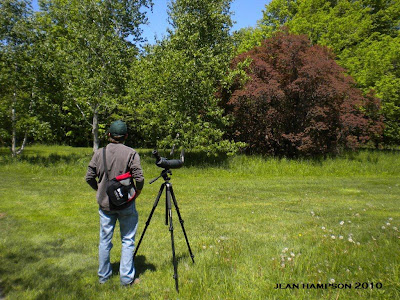
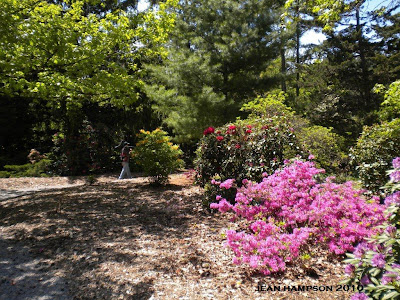
We observed Chimney Swifts the day before while in downtown Niagara Falls so we purposely drove down Queen Street to add 4 of them to the count's list.
We then stopped at Dufferin Islands Nature Area and along the Niagara River above the Falls to once again count Black-crowned Night-Heron on the small island behind the barge.

Swallows flew over the rapids and we added Northern Rough-winged to the year list.
At the bridge in Chippawa we added another species of swallow to the year list. Now we have two locations we can find Cliff Swallow. All that remains is Bank Swallow and we know where we can find them.
While in Chippawa we visited the feeders and though no first of the years were observed we did get 1 Tufted Titmouse for the BOS count.
At the southern edge of our area we drove down a rural road in search of species to add to the count's list. 5 Bobolink (#137) were observed. The last bird added for the count was a Wild Turkey at the side of the highway.
Jean and I observed a total of 69 species for the BOS count and added 19 species to the year list. We have bridged the gap and are now only 1 species shy of last year's list. The best bird of the day of course was the LIFER Clay-colored Sparrow. That 300th lifer is getting closer and closer. Will we get it on the Carden Alvar OFO trip? We'll try.


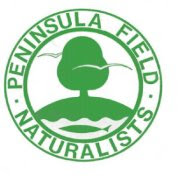





No comments:
Post a Comment